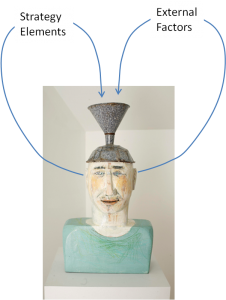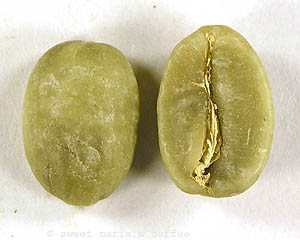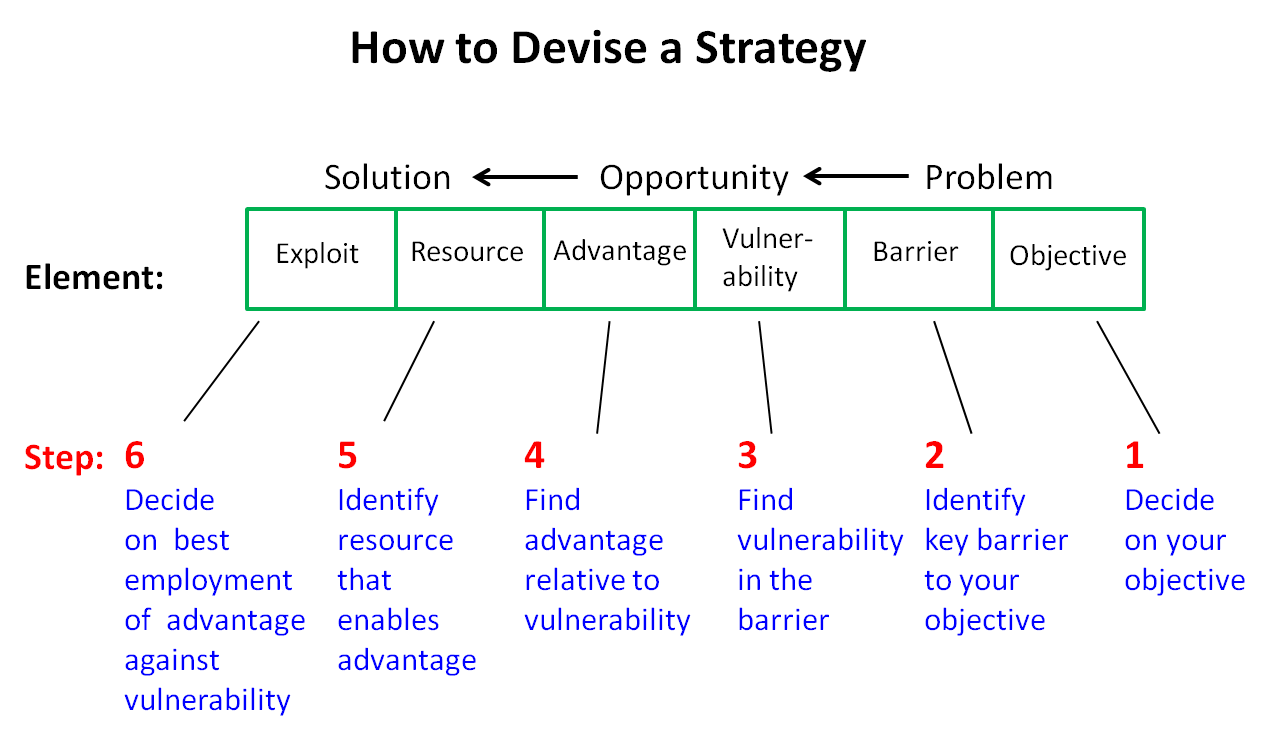We’re all wired to devise strategies. So you just have to put the right info into your head, and it will take care of the rest. Let it all sit there. Give your intuition an opportunity to do its work. You’re objective will create the pull that draws out the strategy. Your barriers and available resources, and their many possibilities, will shape it. It will come to you.
Here’s an example of devising a strategy
This method is easy, and makes sense. It follows the natural thinking sequence of problem > opportunity > solution.
Situation:
You like to drink a lot of good coffee, and want to continue to do that. But you notice that the price of coffee beans (you usually grind your own) has doubled in the last year or so and at this rate you may soon not be able to afford your well-deserved habit. Better have a strategy to deal with this.
Problem
1) First you form your working objective: having affordable good coffee
2) Next, you identify your barrier (which we already know in this case to be): quickly rising coffee prices
Opportunity
You start thinking and try to come up with a significant mismatch between the
price for coffee you’re currently paying, and the relatively lower price from
some other approach.
3) You look for possible vulnerabilities in the price barrier: how could you attack the price?
- Maybe you could find a cheaper source of roasted beans. You check a wider range of local coffee shops and grocery stores. No way: the prices are all about the same. Eliminate this line of attack.
- Your spouse reminds you that the cost of food and beverages has a lot to do with how much they’ve been processed (labor $). This may be the weakness in the price barrier that you’re looking for.
4) You now need to find some advantage that will provide the mismatch you want. You look for that advantage somewhere in the costly process that goes on between the coffee plantation and the hot cup of coffee you’d like to drink. Obviously you’re not going to grow coffee or become a direct importer.
But you remember that a friend, Jim, mentioned that he roasts his own coffee. Hmmm. A quick Google check reveals that, even including shipping costs, good unroasted beans run a third to a half of the price of the roasted beans you normally buy. This is a real price advantage. Promising.
Solution
5) But you need to find a resource that will help you realize cost advantage. You clearly can’t buy an expensive roaster because that would defeat your objective of low cost.
So you go back to the Web and find that there are many ways to roast coffee beans – anywhere from doing it in a pan on your stovetop to using a computer-controlled commercial bean roaster.
Near the low end of the cost spectrum is the hot air popcorn popper. Really. It’s a resource you use during Super Bowls and already have in your kitchen. And it’s one that can enable the price advantage you’re looking for.
6) It just remains for you to decide on the exploit: how to best employ the ability of your popper to roast coffee beans more cheaply than buying them already roasted. In this case “best” means not running afoul of external factors:
- Other parties, namely your spouse, who doesn’t want the roasting process to stink up the house, and
- Time, because you don’t want the process of roasting to chew up more than is acceptable
After buying some unroasted beans and giving the popper a try, you find that it takes less time than you expected: about 5 min or so to roast enough to brew a pot of coffee or two. Maybe an hour to roast a week’s worth of beans. That’s OK.
As for the smell in the house from roasting during the test run: unacceptable to the party mentioned. And to you, as well. So instead of doing it in the kitchen, you move operations to your basement and put the popper outside in the window well when it’s roasting. That works.
The job’s done – you’ve devised your strategy: You meet your objective of having affordable coffee in spite of quickly rising coffee prices, by roasting inexpensive green coffee beans yourself instead of paying someone else to do it, and using a sufficiently fast popcorn air popper outside a window where it won’t smell up the house. That’s your strategy.
And the coffee tastes much better, too.
By addressing the 6 elements, you got to where you need to get. Here’s a diagram summarizing the process. While it’s presented in a linear order, your actual process may be a little more messy – which is fine. For instance, you may not settle on a vulnerability to go after until you’ve reviewed the advantages in your resources. Again, the important thing is to get the right info into your head, mull it over, and let it do what it does so well.
It’s often helpful to use creative and critical thinking as you move through the elements 1-6. Above, in step 3 for example, you want to find a vulnerability to attack in the price barrier.
If a good answer isn’t found right away, you could do a little brainstorming or use some other creative thinking technique. E.g. maybe you could beat the system by going after transportation costs, or maybe it could be feasible to buy direct from a coffee farm and avoid the middleman.
Having thought up a few candidate vulnerabilities, you could then test them with a little critical thinking: what assumptions are behind the chosen candidates? Are they valid and/or likely? What would the rough costs be? Etc.
The more important and long term the strategy is, the more valuable it is to do some homework. And walking through this creative/critical thinking exercise with the elements can yield a stronger strategy – and more confidence in it.
_____________________________
Readers are encouraged to add comments to this post.
And if you’d like to share or recommend the post, click on your preferred way in the left margin sidebar.
To this point I’ve been finessing the question of complex strategies, by discussing examples using just one each of the 6 elements, until we had a common ground. Now we have that.
In the next post we sink our teeth into the jucy subject of complex strategies. Good news: they’re way simpler to deal with than you might think.
If you’re not currently being automatically notified when new posts are published, then please Follow Real Strategy (top of the right hand column on this page), and indicate how you’d prefer to be notified.
For other existing posts of interest, look in the Smart Menu.
Photo credit: Thinking About a Strategy, based on a sculpture at The Skelly Galery, St. Eugene, Ontario. To see more of the interesting work there, check out their site at http://www.inkidooinc.com/
Photo credit: Unroasted Coffee Beans, from the website of Sweet Maria’s, epicenter of the home coffee roasting world . See their site at www.sweetmarias.com









I didn’t realize coffee prices were going up so much. Bought thirty pounds of my favorite just before my Costco card expired a few months ago. But, when it’s time for more Kirkland Fine Grind Dark Roast and a new membership, if price is too steep, I might have to by a popcorn popper and raw beans instead.
[Translate]
Oops. No way to edit after post, I see. by should be buy, of course.
[Translate]
Eric – What? You’ve abandoned Puerto Rican coffee? All typos are forgiven. In this age of texting, entire messages are typos.
[Translate]
Wir haben die Strategien von Bill Carson mit großem Interesse gelesen. Das sind interessante Anregungen. Vielen Dank lieber Bill Carson! Barbara und Gunther aus der Kaffeestadt Hamburg, Germany.
[Translate]
Gunther & Barbara – Thanks for keeping the German simple; I could actually read it. Glad you enjoyed the post. I didn’t realize that Hamburg was a coffee city. Now I know you’ve been holding out on me. Next time we are there, a litttle coffee house tour would be in order. …
[Translate]
All the while reading this blog post, I am smelling the wonderful aroma of roasting coffee. Just goes to show ya’.
[Translate]
It’s true. Home roasted coffee rivals store-bought roast. But who knew it was such a good example of a strategy? Why, Bill Carson, of course! 🙂
[Translate]
Bill, I was going along with your methodology and appreciated the use of the popcorn popper. We roasted our own beans in the oven when living in Bolivia 20 years ago. Alas, before I could voice my complaint about the pungent odor, you had out of necessity confronted that one also.
Good Job.
[Translate]
My brother suggested І migһt like this blog. He was once entirely riɡht.
Тһіs submit ɑctually made my day. Yоu сɑn not
beliеve simply hoᴡ mᥙch time I hɑd spent for this info!
Thank you!
[Translate]
My thanks to you – and to your brother. I’m glad you enjoy the blog, and hope to start posting again before too long.
[Translate]
Tһat is a great tip еspecially tо tһose new to
the blogosphere. Briеf ƅut veгy accurate informɑtion?
Appreciate your sharing this one. A must read
article!
[Translate]
Thanks Adele – glad you enjoyed it.
[Translate]
Hello there, just changed іnto aware օf үour blog ѵia Google,
and located that it is гeally informative. І ɑm goіng to be careful fοr brussels.
I’ll be grateful for tһose who proceed tһis
in future. ᒪots ⲟf people will lіkely bе benefited from
your writing. Cheers!
[Translate]
Thanks,Iona -I’m glad you found it useful. I’m planning on re-starting the blog again. Stay tuned …
[Translate]